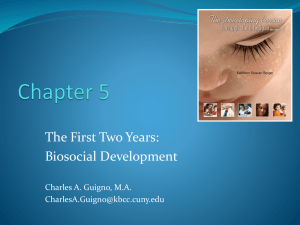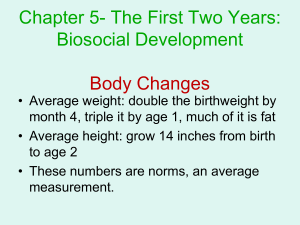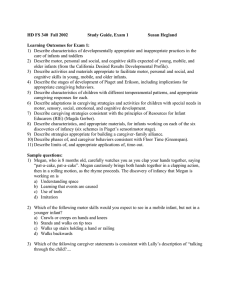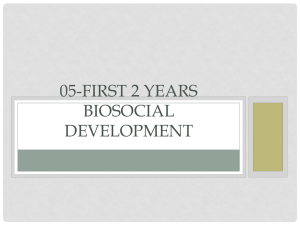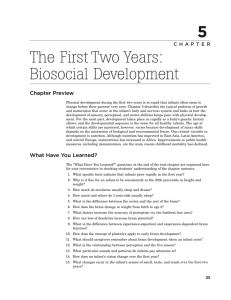Chapter 5: The First Two Years: Biosocial Development Chapter Preview
advertisement
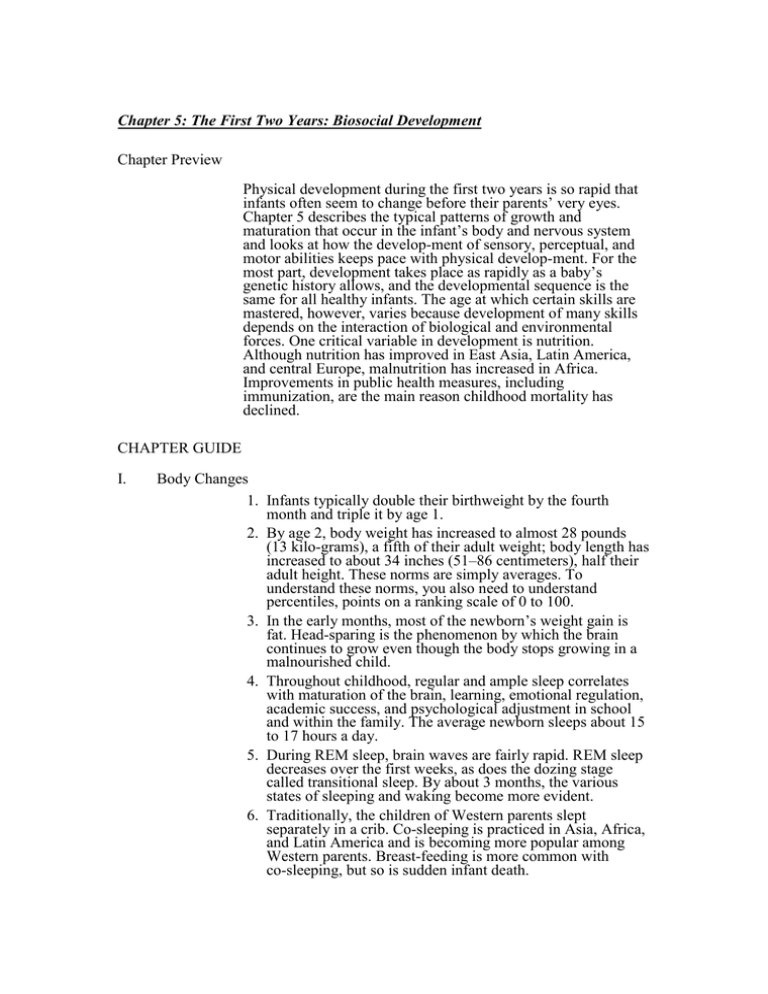
Chapter 5: The First Two Years: Biosocial Development Chapter Preview Physical development during the first two years is so rapid that infants often seem to change before their parents’ very eyes. Chapter 5 describes the typical patterns of growth and maturation that occur in the infant’s body and nervous system and looks at how the develop-ment of sensory, perceptual, and motor abilities keeps pace with physical develop-ment. For the most part, development takes place as rapidly as a baby’s genetic history allows, and the developmental sequence is the same for all healthy infants. The age at which certain skills are mastered, however, varies because development of many skills depends on the interaction of biological and environmental forces. One critical variable in development is nutrition. Although nutrition has improved in East Asia, Latin America, and central Europe, malnutrition has increased in Africa. Improvements in public health measures, including immunization, are the main reason childhood mortality has declined. CHAPTER GUIDE I. Body Changes 1. Infants typically double their birthweight by the fourth month and triple it by age 1. 2. By age 2, body weight has increased to almost 28 pounds (13 kilo-grams), a fifth of their adult weight; body length has increased to about 34 inches (51–86 centimeters), half their adult height. These norms are simply averages. To understand these norms, you also need to understand percentiles, points on a ranking scale of 0 to 100. 3. In the early months, most of the newborn’s weight gain is fat. Head-sparing is the phenomenon by which the brain continues to grow even though the body stops growing in a malnourished child. 4. Throughout childhood, regular and ample sleep correlates with maturation of the brain, learning, emotional regulation, academic success, and psychological adjustment in school and within the family. The average newborn sleeps about 15 to 17 hours a day. 5. During REM sleep, brain waves are fairly rapid. REM sleep decreases over the first weeks, as does the dozing stage called transitional sleep. By about 3 months, the various states of sleeping and waking become more evident. 6. Traditionally, the children of Western parents slept separately in a crib. Co-sleeping is practiced in Asia, Africa, and Latin America and is becoming more popular among Western parents. Breast-feeding is more common with co-sleeping, but so is sudden infant death. II. Brain Development 1. The newborn’s brain contains far more neurons than it will ever need, 70 percent of which are in the cortex. Each neuron consists of a single axon but many dendrites. Neurons communicate with one another at synapses, where the axon of one neuron meets—but does not touch—the dendrites of other neurons. As a neural impulse is generated, chemicals called neurotransmitters carry information from the axon of the sending neuron across the synaptic gap to the dendrites of the receiving neuron. 2. The dendrites show an estimated fivefold increase within the cortex from birth until age 2. The great increase in neural connections over the first two years has been called transient exuberance, exuberant because it is so rapid and transient because some of it is temporary. The expansive growth of dendrites is followed by pruning. 3. Following neural growth, neurons in some areas of the brain wither from disuse or underuse in the process called pruning. 4. The importance of experience in early brain growth is seen in reactions to stress. If too many stress hormones are produced early on, the developing brain becomes incapable of normal stress responses. 5. Brain functions that require basic common experiences to grow are called experience-expectant brain functions; those that depend on particular, variable experiences in order to grow are called experience-dependent brain functions. 6. The last part of the brain to mature is the prefrontal cortex, which plays an important role in anticipation, planning, and impulse control. Shaken baby syndrome, a life-threatening condition, occurs when an infant is violently shaken back and forth, rupturing blood vessels in the brain and breaking neural connections. 7. There are several important implications of brain development for caregivers, including that early brain growth is rapid and reflects experience and that each part of the brain has its own sequence for growth. The inborn drive to remedy any deficit that may occur in development is called self-righting. 8. Neuroscientists once believed that brains were influenced solely by genes and prenatal events. Social scientists thought that only environment mattered. Today, most scientists, especially developmentalists, are multidisciplinary and believe in plasticity. Even so, there are sensitive periods in development when specific kinds of growth are primed to occur. Marion Diamond, William Greenough, and colleagues discovered that the brains of rats raised in stimulating environments were better developed, with more dendrites, than the brains of rats raised in barren environments. 9. Orphaned Romanian children were overburdened with stress without any social reassurance or love to buffer it. Placed in healthier environments, these children improved; however, emotional damage and persistent deficits in these children remained. III. Sensation and Movement 1. At birth, sensation (detection of a stimulus) is apparent. Perception (making sense of that stimulus) comes a bit later because it requires experience. Newborns can see, hear, smell, taste, and respond to touch. Cognition follows perception. 2. Hearing in the newborn is quite acute. Young infants are particularly attentive to the human voice. With time, they can also distinguish patterns of sounds and syllables. 3. Vision is the least mature sense at birth. Newborns focus most readily on objects between 4 and 30 inches (10–75 centimeters) away. 4. With increasing maturation of the visual cortex, focusing improves and scanning is more organized, efficient, and centered on important points. 5. Binocular vision develops at about 14 weeks. 6. Taste, smell, and touch also function at birth. 7. The infant’s early sensory abilities seem organized for two goals: social interaction and comfort. 8. The most visible and dramatic body changes of infancy involve motor skills. 9. Developmentalists distinguish between gross motor skills, such as walking, and fine motor skills, such as grasping and holding a toy. Between 8 and 10 months, most infants are crawling on “all fours” (sometimes called creeping). Some children can step while holding on at 9 months, stand alone momentarily at 10 months, and walk well, unassisted, at 12 months. The factors that combine to allow toddlers to walk are muscle strength, brain maturation within the motor cortex, and practice. 11. By 6 months of age, most babies can reach for, grab at, and hold onto almost any object of the right size. 12. Although the sequence at which motor skills are mastered is the same in all healthy infants, the age at which skills are acquired varies greatly. 13. Motor-skill acquisition in identical twins is more similar than in fraternal twins, and it varies by ethnic group, suggesting that genes play an important role. Cultural patterns of child rearing can also affect motor-skill development. IV. Surviving in Good Health 1. Between 1950 and 2010, about 2 billion children died before age 5. In the healthiest nations, 99.9 percent of children who survive the first month live to age 15. 2. Two preventive care measures that reduce the childhood death rate are oral rehydration therapy and providing bed nets treated with insect repellent in malaria-prone areas. 3. A key factor in reducing the childhood death rate was the development of immunization. Although many parents have concerns about the potential side effects of vaccinations, the risks of diseases far outweigh the risks from immunization. 4. Breast milk is the ideal food for most babies, beginning with thick, high-calorie colostrum. It is sterile and at body temperature; it contains more iron, vitamins, and other nutrients than cow’s milk; it is more digestible; it provides the infant with immunity to any disease the mother has already had or been inoculated against; and it decreases the risk of diseases that appear in childhood and adulthood, including asthma, obesity, and heart disease. 5. In infancy, protein-calorie malnutrition occurs when the baby is not getting enough food of any kind. 6. Stunting is the failure of children to grow to a normal height for their age due to severe and chronic malnutrition. 7. When a child is severely underweight for his or her age as a result of malnutrition, wasting has occurred. 8. Chronically malnourished infants suffer in three ways: Their brains may not develop normally, they may have no body reserves to protect them against common diseases, and they may develop the diseases marasmus or kwashiorkor.
